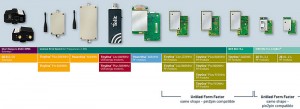M-Bus (Meter-Bus) is a European Standard for the remote reading of gas, water or electricity meters. M-Bus is also usable for other types of consumption meters.
The M-Bus interface is made for communication on two wires, making it very cost effective. This protocol exists with several physical layers such as paired wires, optical fibber or radio link. The radio variant of M-Bus is called Wireless M-Bus and is specified in EN 13757-4. It is dedicated to the European ISM frequency band at 868MHz. It means that modules embedding the Wireless M-bus stack must comply with the general SRD standard EN 300-220.
The Wireless M Bus specification defines 3 different ways to exchange data with remote meters:
- mode S ‘Stationary’
- mode T ‘frequent Transmit’
- mode R ‘frequent Receive’.
1. Mode T
In mode T, the meter sends spontaneously data, either periodically or stochastically.
- In Mode T1, the meter doesn’t care if any receiver is present or not. The meter sends data and returns immediately in IDLE without waiting an ACK. This is a unidirectional communication.
- In mode T2 the meter sends its data and stays awake during a short time immediately after transmission to listen to a possible ACK. If no ACK is received, the meter returns in IDLE. If an ACK appends, then a bidirectional communication link is opened between meter and concentrator.
2. Mode R
In mode R2, the meter doesn’t send spontaneously data. The meter wakes up periodically in RX mode and waits for a wakeup frame received from concentrator. If no frame is received, the meter returns in IDLE. If a valid wakeup frame is received, a bidirectional link is then opened between meter and concentrator.
3. Mode S
- Mode S1 operates exactly as mode T1 (unidirectional spontaneous transmission) but uses a different radio link described below.
- Mode S2 has the same behaviour as mode R (periodic wake up and wait for a wakeup frame before transmitting) but also with a different physical link.
Wireless M-Bus can use 3 different radio links, depending on baud rate and coding format. Moreover short or long
preamble can be used depending of used mode.
Radio Link A
This radio link operates at 868.3 MHz, the radio baud rate is 32.768 kcps and data coding is Manchester.
Radio Link B
This radio link operates at 868.95 MHz, the baud rate is 100 kcps and data coding is “3 out of 6â€.
Radio Link C
This radio link operates at 868.03 MHz, the baud rate is 4.8 kcps and data coding is Manchester.
The Wireless M-Bus stack is available on some references of TELIT TinyOne family. It is applicable for :
- TinyOne Plus 868MHz (RF module, terminal and USB Dongle)
- TinyOne Lite 868MHz (RF module and USB Dongle)
Further the stack can be used on a microcontroller connected to Infineon´s Wireless Control Transceivers/Receivers/Transmitters chips.
Please feel free to contact us to get further informations about Wireless M-Bus solutions or similar protocols, like 6loWPAN, ZigBee, ANT, M-One and others.